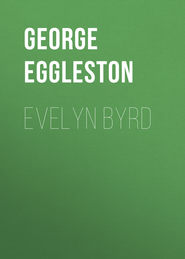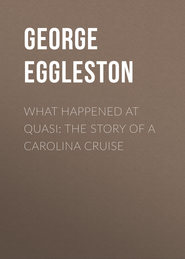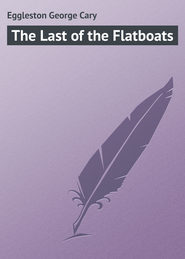По всем вопросам обращайтесь на: info@litportal.ru
(©) 2003-2025.
✖
Camp Venture: A Story of the Virginia Mountains
Настройки чтения
Размер шрифта
Высота строк
Поля
Having felled his share of them, Jack went a little further into the woodlands, and began blocking out great chips from one after another big chestnut tree. Having blocked out these chips, Jack sat down and began to split them, observing the result in each case with care. Presently he satisfied himself and set to work to cut down the giant chestnut whose chip had yielded the best results.
"What's all that for, Jack?" asked the Doctor. "Why did you split up those chips in that way, like a little boy with a new hatchet?"
"I was hunting for some timber that isn't 'brash,'" answered Jack, "to make our clapboards out of."
"What do you mean by 'brash?'"
"Why, some timber splits easily and straight along its grain, while other wood breaks away slantwise across the grain. That last kind is called 'brash,' and, of course, it is of no account for clapboards. See here!" and with that he took up two of the big sample chips and illustrated his meaning by splitting them and showing the Doctor how one of them split straight with the grain, while the other showed no such integrity.
"Oh, then, you're going to make clapboards out of this tree to roof our shanty with and to close up its gables."
"I'm going to make clapboards for our roof," answered Jack, "but not for our gables. They'll be made of logs, in true mountain fashion."
"But how is that possible?" eagerly asked the Doctor.
"I'll show you when we come to build. I can't very well explain it in advance. And another thing, Doctor, you remember that we have only ten pounds or so of nails, all told."
"That's true!" exclaimed the Doctor, almost in consternation. "We can't roof our house till somebody goes down the mountain and brings a supply."
"That's where you are mightily mistaken, Doctor. There isn't a log cabin in these mountains that has a nail in its roof."
"But how then are the clapboards held in place?"
"That again is a thing I can show you far better than I can explain it without demonstration. But we must first get our clapboards, and if you'll go back to the camp and bring a cross cut saw, I'll have this giant of the forest laid low by the time you get back, and then you and I will cut it into four-foot lengths for clapboards."
It should be explained that in the mountains of Virginia the word "clapboard" and the simpler word "board," mean something quite different from what they signify elsewhere. When the Virginia mountaineer speaks of a "board" or a "clapboard" he means a rough shingle, four feet long, simply split out of a piece of timber and not dressed in any way.
When the Doctor returned with the cross cut saw, Jack first marked off ten feet of his great tree at the butt and the two set to work to sever it.
"But you said we were to cut it into four-foot lengths," said the Doctor, as they began to pull the saw back and forth.
"So we are," answered Jack, "after we saw off this butt. You see, the butt of a tree is always rather brash, and so we won't use that for clapboards. Besides, I've another use for it."
"What?" asked the Doctor.
"I'm going to dig it out into a big trough and make a bath tub out of it. You see, that spring up there under the cliff has a fine flow of water. I'll sink this trough in the ground, at a proper angle, and train the water into it. It will run in at one end and out at the other, continually, so we'll always have a fresh bath ready for any comer."
"But will the boys relish a cold bath out of doors when the thermometer gets down into the small figures?"
"Well they'd better. Little Tom is a crank on cold bathing in the morning, and if any fellow in the party doesn't relish that sort of thing, Tom will souse him in any how till he teaches him to like it. He won't do you that way, Doctor, of course, but – "
"But why not? I need the tonic influence of cold morning baths more than anybody else in the party, and as soon as we get our bath tub in place I shall begin taking them. And more than that, I'll help little Tom in the work of dousing any boy in the party that neglects that hygienic regimen."
Having sawed off the butt of this big tree, Jack went back to the house site and directed the boys as to the work of building. The forty sticks of timber already cut, when piled into a crib would make the body of a cabin nearly twenty feet square, allowing for the overlapping of the timbers, and about ten feet high under the eaves. Jack showed the boys how to notch the logs at their ends so as to hold them securely in place and so also as to let them lie very close together throughout their length. For, of course, without notching, each log would lie the whole thickness of another log above the timber below it. Having thus started the four in the work of building, he returned to the woods where he and the Doctor continued the work of sawing the big tree trunk into four-foot lengths. About noon the Doctor volunteered to go and prepare a roast venison dinner, and Jack proceeded to split the tree-lengths into sizes convenient for the riving of the clapboards.
By the time that he had accomplished this, the Doctor whistled through his fingers to announce dinner, and every member of the party was eagerly ready for the savory meal, the very odor of which made their nostrils glad while they were washing their hands and faces in preparation for it. There were not many dishes included in it – only some sweet potatoes roasted in the ashes, and some big pones of black ash cake, to go with the great haunch of roast venison.
Ash cake is a species of corn bread, consisting of corn meal mixed up with cold water and a little salt, and baked hard in a bed of hot ashes and hotter coals, and if any reader of this story has ever eaten ash cake, properly prepared, I need not tell him that there is no better kind of bread made anywhere – no, not even in Paris, a city that prides itself about equally upon its "pain" – bread, – and its paintings, of which it has the finest collections in all the world. Finally, there was the sauce – traditionally, the best in the world, – namely, hunger. Half a dozen young fellows high up on a mountain side, who had breakfasted before daylight and swung axes and lifted logs till midday, needed no highly-spiced flavoring to give savor to their meat. They ate like the healthy, hard working fellows that they were, and they had no fear of indigestions to follow their eating.
After dinner the work of building went on apace. The main crib of the house was finished by noon of the next day, and the roof and gables only remained to be completed after that. This was to be done as follows:
Logs to form the gables were cut, each a few feet shorter than the one below. Then poles six inches in diameter were cut to form a resting place for the clapboards, and were placed lengthwise the building, resting in notches in the steadily shortening gable timbers. The gable timbers were permitted, however, to extend two feet or so beyond the notches in which the lengthwise poles rested, and a second notch was cut in each end of each of them. When a row of clapboards was laid on the lengthwise poles, another lengthwise pole was placed on top to hold the clapboards in place, and this top pole rested in the outer notches of the gable logs, thus securely holding the roof in position, and as the clapboards overlapped each other as shingles do, the roof was rainproof.
Meantime Jack had been riving clapboards with a fro. Does the reader know what a fro is? The dictionaries do not tell you in any adequate way, though in Virginia and throughout the south and the great west that implement has played an important part in enabling men to house themselves with clapboards or shingles for their roofs. So I must do the work that the dictionaries neglect. A fro is an iron or steel blade about eight or ten inches long, about three inches wide, a quarter of an inch thick at top, tapering to a very dull edge at bottom. In one end of it is an eye to hold a handle.
The fro is used in splitting out clapboards and rough shingles. The operator places its dull edge on the end of a piece of timber of proper width, at the distance of a clapboard's thickness from the side of the timber. Then he hits the back of the fro blade with a mallet or club, driving it well in like a wedge. Then, by working the handle backwards and forwards, and pushing the fro further and further into the crack, as it opens, he splits off a shingle, or a clapboard, as the case may be. In the south, and in some parts of the west nearly all of the shingles and clapboards used are still split out in this way with the fro. Until recent years, when shingle making machines were introduced, all shingles were made in that way, so that next to the axe, and the pitsaw, which used to do the work now done by the saw mill, the fro played the most conspicuous part in the creation of human habitations in all that pioneer period when sturdy arms were conquering the American wilderness and stout hearts were creating the greatness in which we now rejoice. It is stupid of the dictionaries not to tell of it.
In splitting out his clapboards from three-cornered sections of his chestnut logs, Jack gradually reduced those sections to a width too small for the further making of clapboards. This left in each case a three-cornered stick two inches thick at its thickest part, and perhaps three inches wide to its edge. The Doctor wanted to utilize these sticks for firewood and proposed to carry a lot of them to the temporary shelter for that purpose.
"Not by any means," said Jack. "Those wedge-shaped pieces are to be used for chinking."
"What's chinking?" asked the Doctor.
"Why, you see," answered Jack, "the logs of which our house or hut is built, are not quite straight, though they are the straightest we could find in the woods. There are spaces between them that are open, and when the zero weather comes we should be very uncomfortably cold in there if these spaces remained open. No fire that we could make in our chimney would keep us warm under such conditions. So we must stop up the cracks. We'll do that by fitting these pieces of chinking into the cracks between the logs, and then 'daubing' the smaller cracks with mud. That's an operation that will try your resolution, Doctor, and determine whether you are really only sixteen years old, as we voted that you were, or are a much older person, to be specially considered by us boys – for I don't know any more disagreeable job than daubing a log cabin."
"Good!" answered the Doctor. "I'll submit myself to the test very gladly. You'll show me how to 'daub' of course, and if I don't 'daub' with the best and youngest of you, then I'll give up and go down the mountain, acknowledging myself a failure. But I give you fair warning that I don't expect or intend either to give up or to go down the mountain."
"We should all be very sorry if you did, Doctor. We've adopted you now. We've decreed that for this winter, at any rate, you are only sixteen years of age, and upon my word, if you'll allow me to say so – "
"Now, stop right there," broke in the Doctor. "Don't say 'if you'll allow me to say so.' That undoes the whole arrangement. You fellows have accepted me as a boy among boys, and you've got to stick to that. There are to be no deferences to me. There is to be precisely the same comradeship between me and the rest of you that exists among yourselves, otherwise I shall consider myself an intruder."
"All right," responded Jack, seizing the Doctor's hand and pressing it warmly. "We all feel that you are altogether one of us, and I for one shall hereafter treat you as such. So when the daubing time comes I'll set you your task like the rest of them and I'll criticize every crevice you leave open. What with an open roof – for a clapboard roof is very open – through which the wind can blow at its own sweet will, and what with the necessity of keeping the door open most of the time for light, it's going to be very hard work to keep the place comfortably warm."
"But why keep the door open for light?" asked the Doctor. "Why not let in the light through windows?"
"We haven't any windows," answered Jack, "and we haven't any sash or glass to make them with."
"Of course not," said the Doctor, "but still, if you'll let me, I'll show you how to have windows that will keep out the wind and let in light at the same time. I've all the necessary materials in my shoulder pack."
"I can't guess how you're going to do it, Doctor, but at any rate I accept your statement, and if you'll tell me what sized openings you want in the walls for your windows, I'll go at once and saw them out."
"That's what troubles me," said the Doctor. "I don't see how we are going to make window openings without sawing through the logs, and I don't see how that is to be done without weakening the structure, and letting the unsupported ends of the logs fall out of place."
"Oh, that's easy enough," answered Jack. "You tell me what sized window openings you want in our walls, and I'll take care of the logs."
The Doctor thought a moment, and then said:
"Well, we ought to have two windows, each about two feet and a half one way by about three feet or a little more the other way."
"Does it make any difference," asked Jack, "whether the long way is up and down, or to the right and left?"
"None. You can make the openings long either way and short either way."
"Good!" answered Jack. "Then I'll make them long to right and left and short in their up and down dimensions, so that I shall have to saw out only two logs for each window."
Jack went immediately to work. He split out six or eight boards, each four times the thickness of any ordinary clapboard, and, taking a handful of the small supply of nails on hand, went to the cabin now well advanced in construction, and selected the places for the two window openings. Then he nailed the thick boards securely to the logs, one on each side of one of the proposed window openings. The boards were long enough to reach over four of the logs. Jack nailed them securely to all four of the logs, thus binding the timbers together, and making each a support to all of the others. Then he sawed out three-foot lengths of the two middle logs, leaving their ends securely supported by the boards which were firmly nailed to them, and also to the uncut logs above and below. Then, to make all secure, he fitted pieces of his thick boards to the ends of the sawed logs, and nailed them firmly into place as an additional protection against sagging.
"Now, then, Doctor," he called out, "come on with your windows. I'm curious to see what they are like."











